The Legend of the Sugar Girl: A Study of Colonization and Abuse
VerifiedAdded on 2019/10/30
|5
|1365
|3797
Essay
AI Summary
This essay provides an in-depth analysis of Joseph Boyden's "Legend of the Sugar Girl," exploring the devastating impact of European colonization on Indigenous communities in North America. The essay delves into the protagonist's experiences, highlighting the cyclical nature of abuse, addiction, and cultural oppression. It examines how the Sugar Girl, a symbol of the oppressed, grapples with the trauma of residential schools, where Indigenous children were subjected to cultural assimilation and physical and psychological abuse. The essay traces her descent into addiction as a means of escaping the harsh realities of her life, and the subsequent intergenerational transmission of trauma to her son. It also explores the psychological control exerted by colonizers through the introduction of unhealthy foods and the suppression of Indigenous languages and customs. The essay draws on various academic sources to support its arguments, ultimately portraying the enduring legacy of colonization and its profound effect on the lives of Indigenous people.
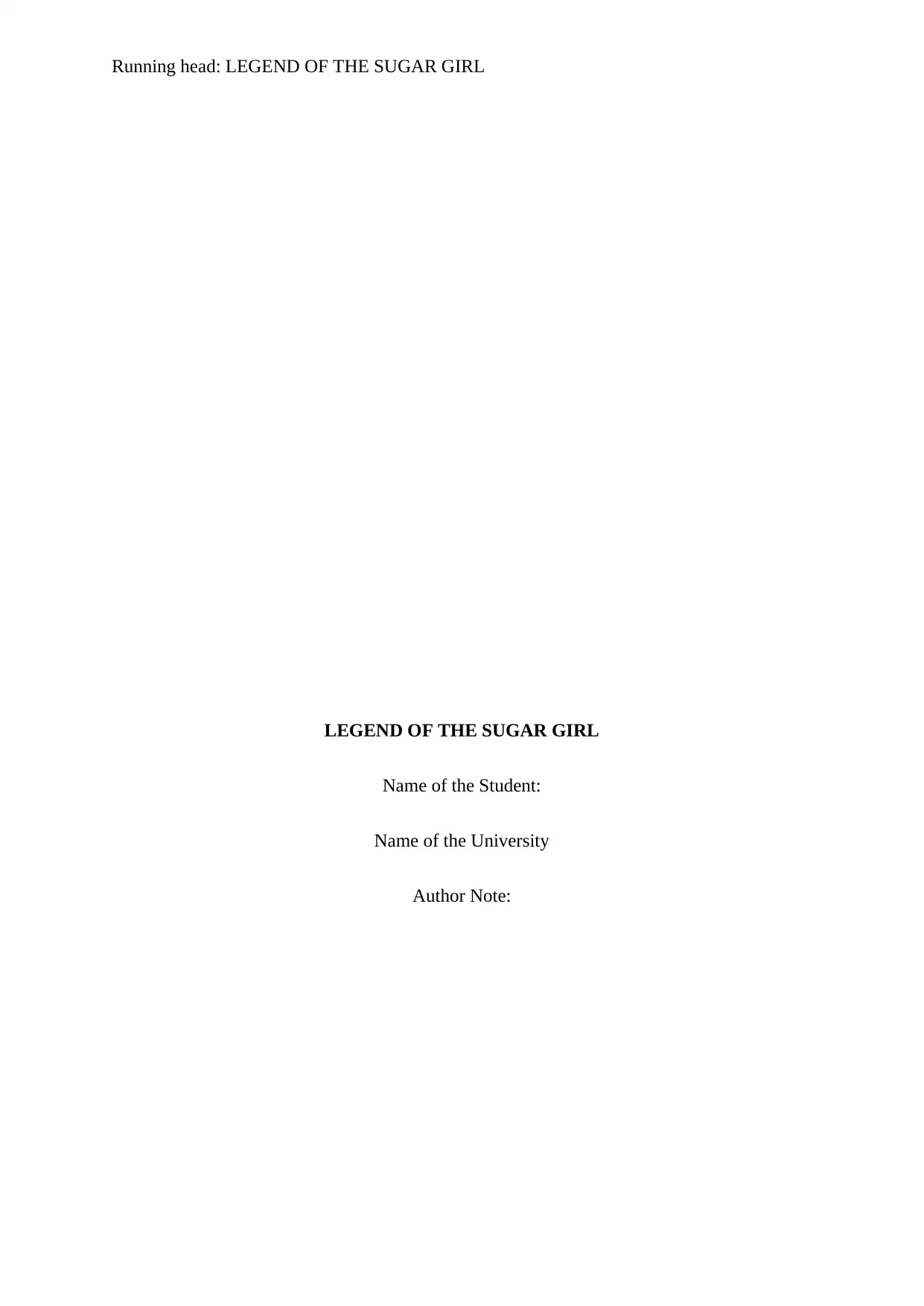
Running head: LEGEND OF THE SUGAR GIRL
LEGEND OF THE SUGAR GIRL
Name of the Student:
Name of the University
Author Note:
LEGEND OF THE SUGAR GIRL
Name of the Student:
Name of the University
Author Note:
Paraphrase This Document
Need a fresh take? Get an instant paraphrase of this document with our AI Paraphraser
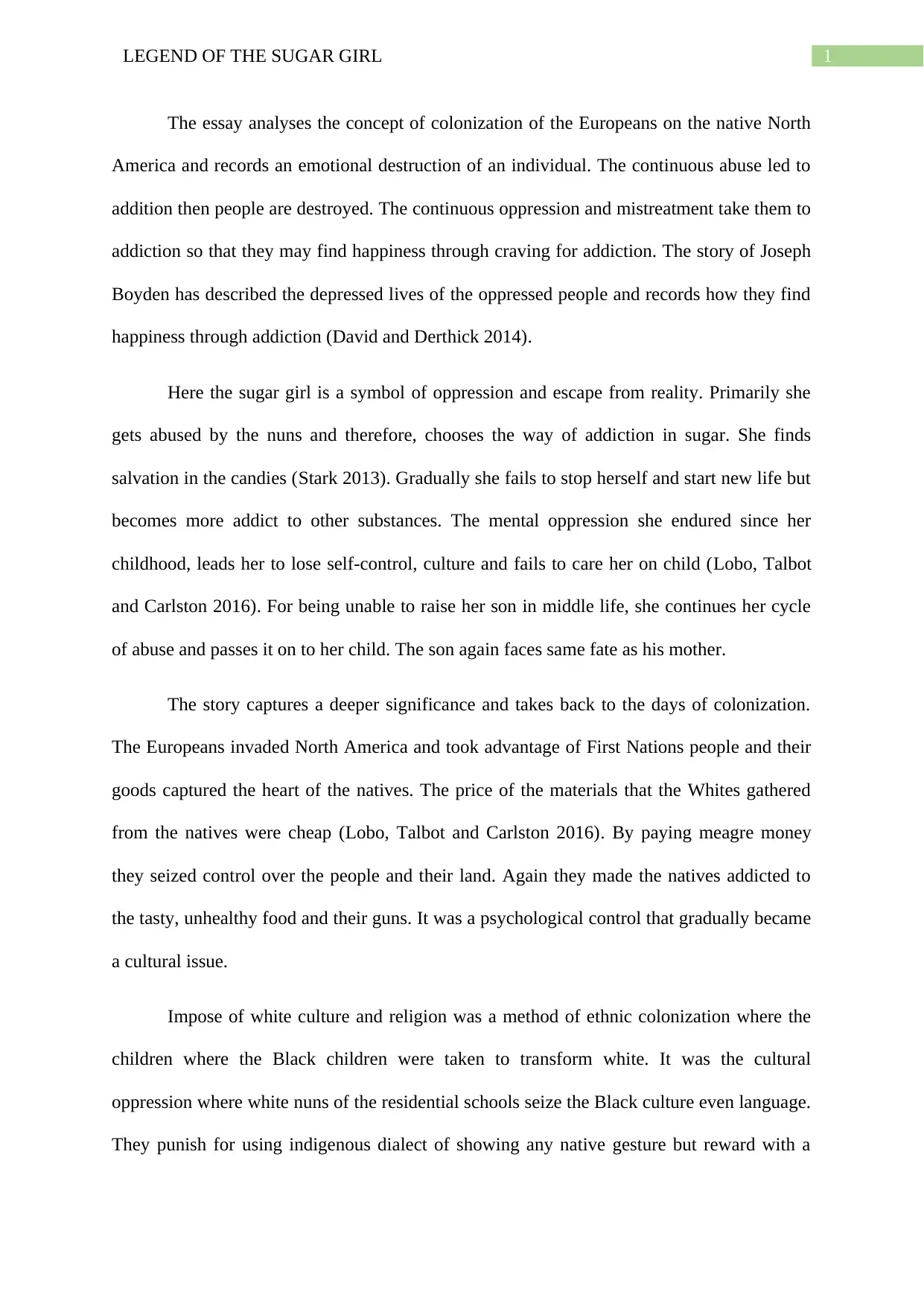
1LEGEND OF THE SUGAR GIRL
The essay analyses the concept of colonization of the Europeans on the native North
America and records an emotional destruction of an individual. The continuous abuse led to
addition then people are destroyed. The continuous oppression and mistreatment take them to
addiction so that they may find happiness through craving for addiction. The story of Joseph
Boyden has described the depressed lives of the oppressed people and records how they find
happiness through addiction (David and Derthick 2014).
Here the sugar girl is a symbol of oppression and escape from reality. Primarily she
gets abused by the nuns and therefore, chooses the way of addiction in sugar. She finds
salvation in the candies (Stark 2013). Gradually she fails to stop herself and start new life but
becomes more addict to other substances. The mental oppression she endured since her
childhood, leads her to lose self-control, culture and fails to care her on child (Lobo, Talbot
and Carlston 2016). For being unable to raise her son in middle life, she continues her cycle
of abuse and passes it on to her child. The son again faces same fate as his mother.
The story captures a deeper significance and takes back to the days of colonization.
The Europeans invaded North America and took advantage of First Nations people and their
goods captured the heart of the natives. The price of the materials that the Whites gathered
from the natives were cheap (Lobo, Talbot and Carlston 2016). By paying meagre money
they seized control over the people and their land. Again they made the natives addicted to
the tasty, unhealthy food and their guns. It was a psychological control that gradually became
a cultural issue.
Impose of white culture and religion was a method of ethnic colonization where the
children where the Black children were taken to transform white. It was the cultural
oppression where white nuns of the residential schools seize the Black culture even language.
They punish for using indigenous dialect of showing any native gesture but reward with a
The essay analyses the concept of colonization of the Europeans on the native North
America and records an emotional destruction of an individual. The continuous abuse led to
addition then people are destroyed. The continuous oppression and mistreatment take them to
addiction so that they may find happiness through craving for addiction. The story of Joseph
Boyden has described the depressed lives of the oppressed people and records how they find
happiness through addiction (David and Derthick 2014).
Here the sugar girl is a symbol of oppression and escape from reality. Primarily she
gets abused by the nuns and therefore, chooses the way of addiction in sugar. She finds
salvation in the candies (Stark 2013). Gradually she fails to stop herself and start new life but
becomes more addict to other substances. The mental oppression she endured since her
childhood, leads her to lose self-control, culture and fails to care her on child (Lobo, Talbot
and Carlston 2016). For being unable to raise her son in middle life, she continues her cycle
of abuse and passes it on to her child. The son again faces same fate as his mother.
The story captures a deeper significance and takes back to the days of colonization.
The Europeans invaded North America and took advantage of First Nations people and their
goods captured the heart of the natives. The price of the materials that the Whites gathered
from the natives were cheap (Lobo, Talbot and Carlston 2016). By paying meagre money
they seized control over the people and their land. Again they made the natives addicted to
the tasty, unhealthy food and their guns. It was a psychological control that gradually became
a cultural issue.
Impose of white culture and religion was a method of ethnic colonization where the
children where the Black children were taken to transform white. It was the cultural
oppression where white nuns of the residential schools seize the Black culture even language.
They punish for using indigenous dialect of showing any native gesture but reward with a
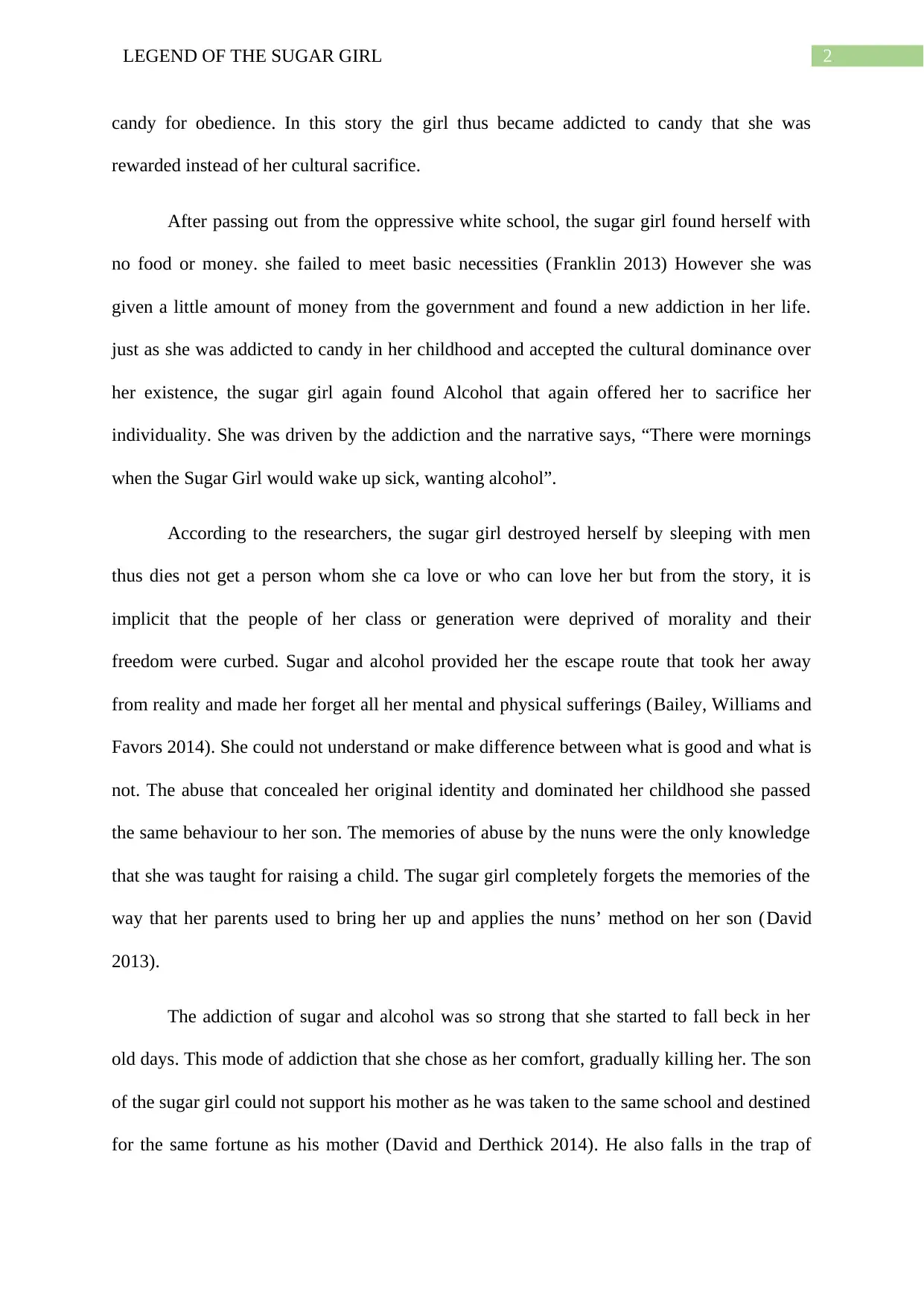
2LEGEND OF THE SUGAR GIRL
candy for obedience. In this story the girl thus became addicted to candy that she was
rewarded instead of her cultural sacrifice.
After passing out from the oppressive white school, the sugar girl found herself with
no food or money. she failed to meet basic necessities (Franklin 2013) However she was
given a little amount of money from the government and found a new addiction in her life.
just as she was addicted to candy in her childhood and accepted the cultural dominance over
her existence, the sugar girl again found Alcohol that again offered her to sacrifice her
individuality. She was driven by the addiction and the narrative says, “There were mornings
when the Sugar Girl would wake up sick, wanting alcohol”.
According to the researchers, the sugar girl destroyed herself by sleeping with men
thus dies not get a person whom she ca love or who can love her but from the story, it is
implicit that the people of her class or generation were deprived of morality and their
freedom were curbed. Sugar and alcohol provided her the escape route that took her away
from reality and made her forget all her mental and physical sufferings (Bailey, Williams and
Favors 2014). She could not understand or make difference between what is good and what is
not. The abuse that concealed her original identity and dominated her childhood she passed
the same behaviour to her son. The memories of abuse by the nuns were the only knowledge
that she was taught for raising a child. The sugar girl completely forgets the memories of the
way that her parents used to bring her up and applies the nuns’ method on her son (David
2013).
The addiction of sugar and alcohol was so strong that she started to fall beck in her
old days. This mode of addiction that she chose as her comfort, gradually killing her. The son
of the sugar girl could not support his mother as he was taken to the same school and destined
for the same fortune as his mother (David and Derthick 2014). He also falls in the trap of
candy for obedience. In this story the girl thus became addicted to candy that she was
rewarded instead of her cultural sacrifice.
After passing out from the oppressive white school, the sugar girl found herself with
no food or money. she failed to meet basic necessities (Franklin 2013) However she was
given a little amount of money from the government and found a new addiction in her life.
just as she was addicted to candy in her childhood and accepted the cultural dominance over
her existence, the sugar girl again found Alcohol that again offered her to sacrifice her
individuality. She was driven by the addiction and the narrative says, “There were mornings
when the Sugar Girl would wake up sick, wanting alcohol”.
According to the researchers, the sugar girl destroyed herself by sleeping with men
thus dies not get a person whom she ca love or who can love her but from the story, it is
implicit that the people of her class or generation were deprived of morality and their
freedom were curbed. Sugar and alcohol provided her the escape route that took her away
from reality and made her forget all her mental and physical sufferings (Bailey, Williams and
Favors 2014). She could not understand or make difference between what is good and what is
not. The abuse that concealed her original identity and dominated her childhood she passed
the same behaviour to her son. The memories of abuse by the nuns were the only knowledge
that she was taught for raising a child. The sugar girl completely forgets the memories of the
way that her parents used to bring her up and applies the nuns’ method on her son (David
2013).
The addiction of sugar and alcohol was so strong that she started to fall beck in her
old days. This mode of addiction that she chose as her comfort, gradually killing her. The son
of the sugar girl could not support his mother as he was taken to the same school and destined
for the same fortune as his mother (David and Derthick 2014). He also falls in the trap of
⊘ This is a preview!⊘
Do you want full access?
Subscribe today to unlock all pages.

Trusted by 1+ million students worldwide
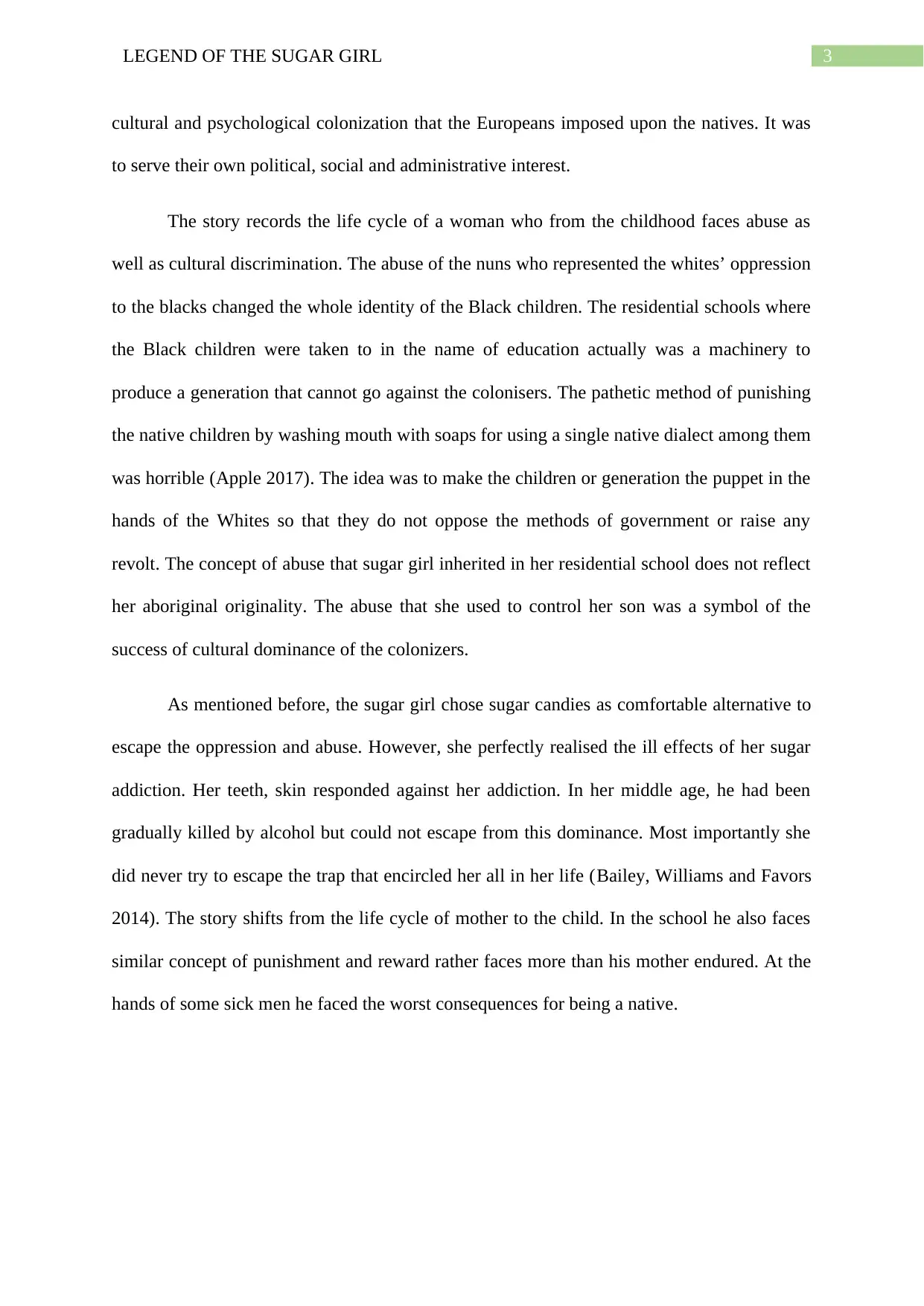
3LEGEND OF THE SUGAR GIRL
cultural and psychological colonization that the Europeans imposed upon the natives. It was
to serve their own political, social and administrative interest.
The story records the life cycle of a woman who from the childhood faces abuse as
well as cultural discrimination. The abuse of the nuns who represented the whites’ oppression
to the blacks changed the whole identity of the Black children. The residential schools where
the Black children were taken to in the name of education actually was a machinery to
produce a generation that cannot go against the colonisers. The pathetic method of punishing
the native children by washing mouth with soaps for using a single native dialect among them
was horrible (Apple 2017). The idea was to make the children or generation the puppet in the
hands of the Whites so that they do not oppose the methods of government or raise any
revolt. The concept of abuse that sugar girl inherited in her residential school does not reflect
her aboriginal originality. The abuse that she used to control her son was a symbol of the
success of cultural dominance of the colonizers.
As mentioned before, the sugar girl chose sugar candies as comfortable alternative to
escape the oppression and abuse. However, she perfectly realised the ill effects of her sugar
addiction. Her teeth, skin responded against her addiction. In her middle age, he had been
gradually killed by alcohol but could not escape from this dominance. Most importantly she
did never try to escape the trap that encircled her all in her life (Bailey, Williams and Favors
2014). The story shifts from the life cycle of mother to the child. In the school he also faces
similar concept of punishment and reward rather faces more than his mother endured. At the
hands of some sick men he faced the worst consequences for being a native.
cultural and psychological colonization that the Europeans imposed upon the natives. It was
to serve their own political, social and administrative interest.
The story records the life cycle of a woman who from the childhood faces abuse as
well as cultural discrimination. The abuse of the nuns who represented the whites’ oppression
to the blacks changed the whole identity of the Black children. The residential schools where
the Black children were taken to in the name of education actually was a machinery to
produce a generation that cannot go against the colonisers. The pathetic method of punishing
the native children by washing mouth with soaps for using a single native dialect among them
was horrible (Apple 2017). The idea was to make the children or generation the puppet in the
hands of the Whites so that they do not oppose the methods of government or raise any
revolt. The concept of abuse that sugar girl inherited in her residential school does not reflect
her aboriginal originality. The abuse that she used to control her son was a symbol of the
success of cultural dominance of the colonizers.
As mentioned before, the sugar girl chose sugar candies as comfortable alternative to
escape the oppression and abuse. However, she perfectly realised the ill effects of her sugar
addiction. Her teeth, skin responded against her addiction. In her middle age, he had been
gradually killed by alcohol but could not escape from this dominance. Most importantly she
did never try to escape the trap that encircled her all in her life (Bailey, Williams and Favors
2014). The story shifts from the life cycle of mother to the child. In the school he also faces
similar concept of punishment and reward rather faces more than his mother endured. At the
hands of some sick men he faced the worst consequences for being a native.
Paraphrase This Document
Need a fresh take? Get an instant paraphrase of this document with our AI Paraphraser
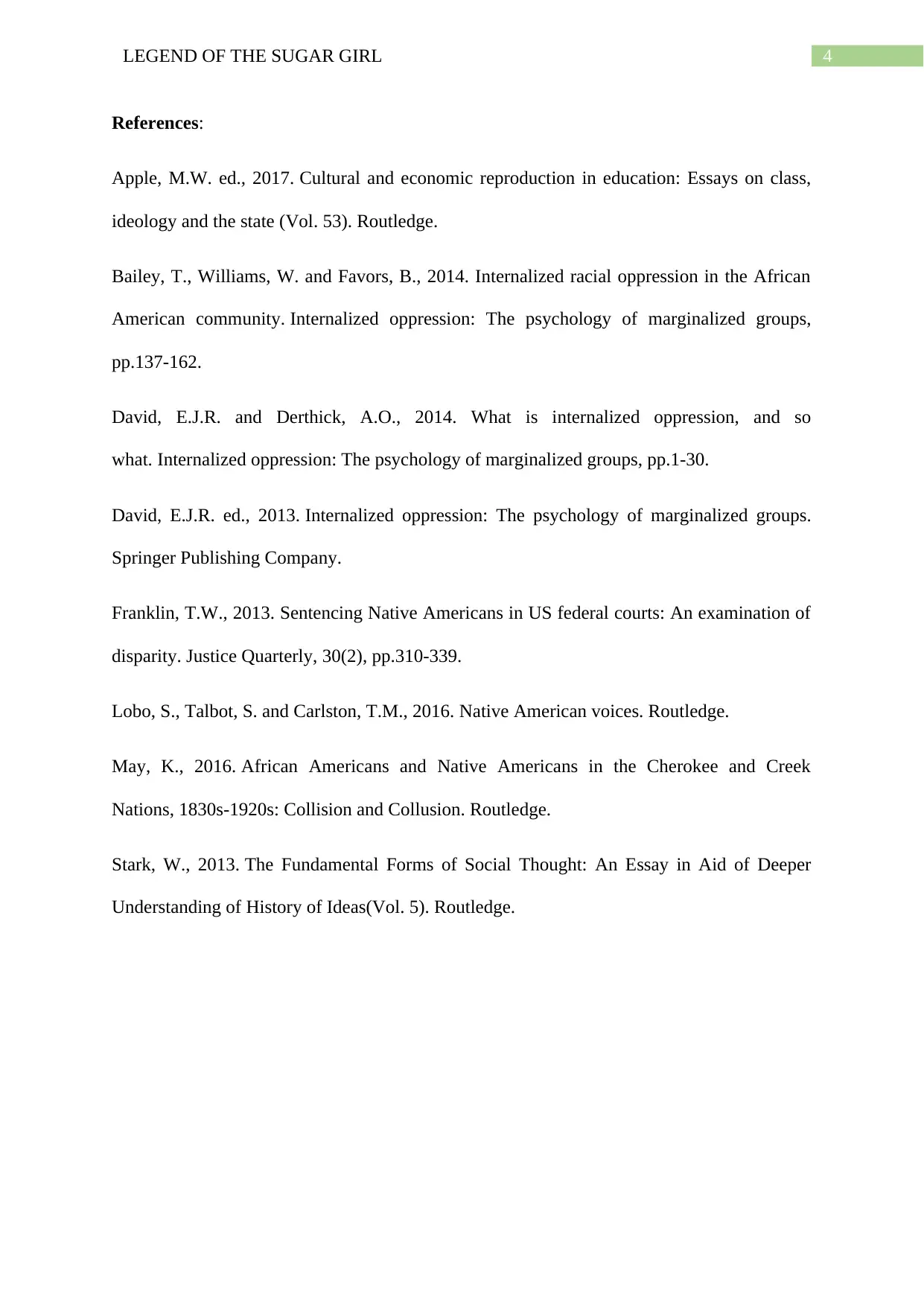
4LEGEND OF THE SUGAR GIRL
References:
Apple, M.W. ed., 2017. Cultural and economic reproduction in education: Essays on class,
ideology and the state (Vol. 53). Routledge.
Bailey, T., Williams, W. and Favors, B., 2014. Internalized racial oppression in the African
American community. Internalized oppression: The psychology of marginalized groups,
pp.137-162.
David, E.J.R. and Derthick, A.O., 2014. What is internalized oppression, and so
what. Internalized oppression: The psychology of marginalized groups, pp.1-30.
David, E.J.R. ed., 2013. Internalized oppression: The psychology of marginalized groups.
Springer Publishing Company.
Franklin, T.W., 2013. Sentencing Native Americans in US federal courts: An examination of
disparity. Justice Quarterly, 30(2), pp.310-339.
Lobo, S., Talbot, S. and Carlston, T.M., 2016. Native American voices. Routledge.
May, K., 2016. African Americans and Native Americans in the Cherokee and Creek
Nations, 1830s-1920s: Collision and Collusion. Routledge.
Stark, W., 2013. The Fundamental Forms of Social Thought: An Essay in Aid of Deeper
Understanding of History of Ideas(Vol. 5). Routledge.
References:
Apple, M.W. ed., 2017. Cultural and economic reproduction in education: Essays on class,
ideology and the state (Vol. 53). Routledge.
Bailey, T., Williams, W. and Favors, B., 2014. Internalized racial oppression in the African
American community. Internalized oppression: The psychology of marginalized groups,
pp.137-162.
David, E.J.R. and Derthick, A.O., 2014. What is internalized oppression, and so
what. Internalized oppression: The psychology of marginalized groups, pp.1-30.
David, E.J.R. ed., 2013. Internalized oppression: The psychology of marginalized groups.
Springer Publishing Company.
Franklin, T.W., 2013. Sentencing Native Americans in US federal courts: An examination of
disparity. Justice Quarterly, 30(2), pp.310-339.
Lobo, S., Talbot, S. and Carlston, T.M., 2016. Native American voices. Routledge.
May, K., 2016. African Americans and Native Americans in the Cherokee and Creek
Nations, 1830s-1920s: Collision and Collusion. Routledge.
Stark, W., 2013. The Fundamental Forms of Social Thought: An Essay in Aid of Deeper
Understanding of History of Ideas(Vol. 5). Routledge.
1 out of 5
Your All-in-One AI-Powered Toolkit for Academic Success.
+13062052269
info@desklib.com
Available 24*7 on WhatsApp / Email
![[object Object]](/_next/static/media/star-bottom.7253800d.svg)
Unlock your academic potential
Copyright © 2020–2025 A2Z Services. All Rights Reserved. Developed and managed by ZUCOL.